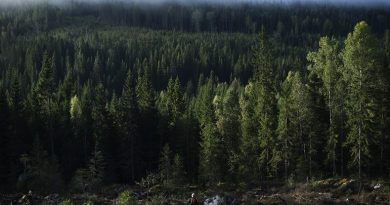Rare snow-white squirrel spotted in Yukon, northwestern Canada

Steve Buyck says when he first caught a glimpse of a little bright-white critter, he thought it was a weasel. Then he saw the bushy tail.
“I knew it was a squirrel right away,” he said.
He and his wife, Elizabeth Blair, were out for a drive Tuesday near Gravel Lake, north of their home in Stewart Crossing, Yukon, in northwestern Canada, when they saw the oddball rodent.
Blair, an amateur photographer, managed to snap a couple of quick photos before the animal disappeared.
“You like to zoom in, but an animal never sits there and poses for you for too long. And so you’re really lucky to get that one shot,” Blair said.
“It was really quick…. It just took right off,” said Buyck.
Neither of them had ever seen anything like it. When they started showing their photos around, people told them they ought to go buy a lottery ticket.

Blair, who is from the White River First Nation, said her aunt told her the animal would be called dlak degay in Northern Tutchone.
“Steve has been in the bush all his life. He’s never encountered one and although we see stuff on TV, I’ve never thought to ask the elders about it,” Blair said.
Not an albino
Meghan Larivee, a wildlife harvest specialist with the Yukon government, agrees — it is a rare sight.
“It’s pretty cool, and it’s a really neat photo to see,” she said.
She figures it’s a red squirrel — common in Yukon — with a leucistic gene. Leucism results in a partial loss of pigmentation. The squirrel’s dark-coloured eye indicates that it’s not an albino.
“[With leucism], the skin is a whiter colour, the hair is a whiter colour, but it doesn’t actually affect the eyes. Whereas in albinism, it’s a complete loss of pigmentation, and that’s why you get that kind of pinky colour in the eye,” she said.
Larivee says leucism doesn’t have any known health risks associated with it, but it would make the critter an easy target for, say, a hungry goshawk — especially this time of year, when squirrels are up in the treetops, hoarding cones.
“So you can imagine a little white squirrel as a flag almost, moving around. It’d be pretty hard to camouflage yourself.”
Buyck says he’s glad he saw it while he could.
“It’s just cool to see a squirrel and, you know, just to kind of record it and make sure that people do know about it,” he said.
“Hopefully there won’t be a whole bunch of people running around Gravel Lake, looking around for this one.”
Written by Paul Tukker, with files from Dave White
Related stories from around the North:
Canada: What you need to know about wildlife photography in Canada’s Northwest Territories, CBC News
Finland: Photographer tells how he snapped picture of rare white bear cub in Finland, Yle News
Sweden: Moose migration in northern Sweden makes for “contemplative” slow TV, Radio Sweden



